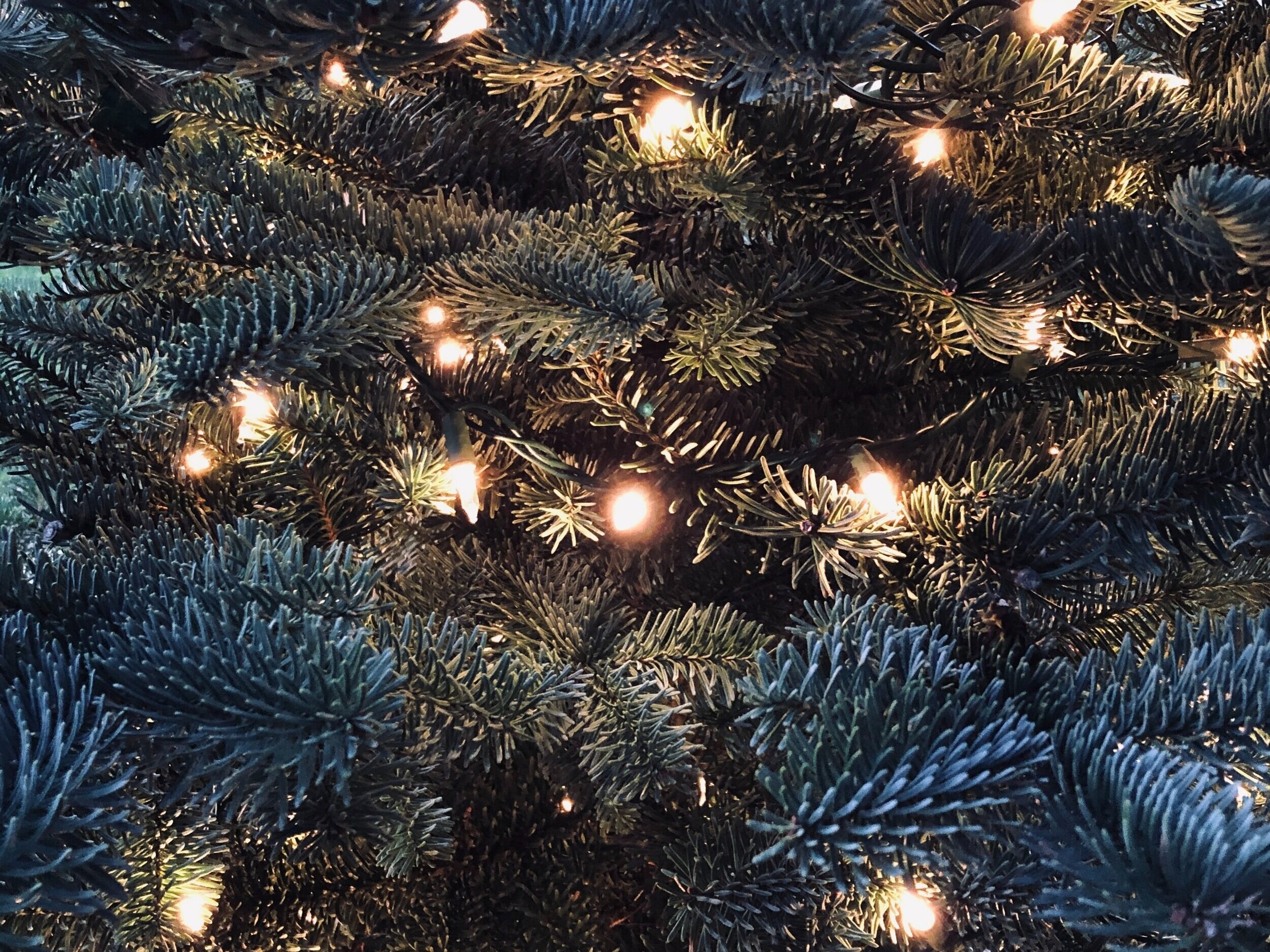12 Green Swaps of Christmas
Hi! I’m Eleanor and I work as part of the volunteer team at Just One Tree
Wow what a year it’s been! In 2020, more than ever, I’m sure many of us are looking forward to kicking back over Christmas, spending time with family (albeit virtually in many cases) and taking our minds off the year that got us here. And, while Christmas is usually a time for pushing out all the stops, and we definitely deserve to celebrate (in some socially distanced, Covid-safe way), there are some easy ways to reduce the environmental footprint of your festivities without breaking the bank or requiring a fine art degree.
Here’s some inspiration for 12 ways to make your Christmas green:
1. No Mo Faux
To go for a plastic tree or a real tree is the eternal debate. A real tree gives you that natural pine smell, but also means you’ll be hoovering up needles well into January. But which one is better for the environment?
A plastic tree has the emissions associated with manufacturing and, unlike a real tree, it won’t biodegrade, but if you keep it forever, long term it could be more sustainable than buying a new fir tree every year. Fir trees also have associated environmental harm – they take up land that could be used for rewilding or food production, they disrupt natural habitats, and the carbon they stored as living plants is released once they are chopped down and decompose.
Well, thankfully, someone else has done the maths for us. Dr John Kazer from the Carbon Trust said in an interview with The Guardian that the real fir tree is still the way to go. The carbon footprint of an artificial tree is around 40kg of greenhouse gas emissions which outweighs the impact of fir trees by up to ten times (depending on how it’s disposed of). You can further reduce the impact of your Christmas tree by buying locally and disposing of it carefully…which leads us to…
2. Recycle or Replant
Anyone who lives in a town with communal bins will be familiar with the January post-Christmas carnage as trees are strewn along the roadside like some kind of post-apocalyptic, foliage nightmare. Trees that end up in landfill will release methane, a greenhouse gas more potent than CO2, as they decompose. The more sustainable options, therefore, are to replant or recycle.
Numerous organisations around the UK provide collection and recycling services, including JustHelping who, after last Christmas, raised over £500,000 for charities and hospices by collecting and recycling 44,228 trees.
Recycled trees can become mulch or biofuel, which is a much better alternative fate than rotting in landfill.
Alternatively, if you buy a pot grown tree, you may be able to replant it and reuse it again next year! There are even charities and garden centres who will rent you a Christmas tree (sometimes complete with decorations) and do the muddy part of replanting it for you.
Our Marketing Advisor, Alexis, has the same tree, 'Christopher', each year and after the festive season, she moves him outdoors to enjoy the fresh air until the following Christmas.
3. Scrap the Wrap
Wrapping paper looks innocent enough in your paper bin but most wrapping paper can’t be recycled because it’s often laminated with plastic or foil or it still has cheeky pieces of Sellotape sticking to it.
Instagram and Pinterest suggest various elaborate alternatives to conventional wrapping paper which require a lot of time and financial investment, and who has either of those right now?
However, there are definitely easier alternatives too, like using wallpaper, newspaper, brown paper for that rustic look, glass jars or scrap fabric. The main tip is to resist the sparkle if you want it to be recyclable. Stay away from glitter (the season’s favourite microplastic) if you can.
There are 100% recyclable wrapping paper options available if you keep an eye out for them. If you want a shiny, festive wrapper, you could always experiment with tin foil (then you save on tape too) so long as it’s recycled in your area.
4. Plastic-Free Decorations
Did you know that in the early 20th Century tinsel was made of lead because it didn’t tarnish so it held its festive, blood-poisoning shine all winter long? Here kids, hang this deadly metal on the tree – Merry Christmas! Thankfully, we did away with that and now it’s time to reduce our consumption of another harmful substance, plastic. There is so much beautiful, plastic-free, festive décor to choose from. Try hanging dried citrus slices, cinnamon sticks, gingerbread biscuits or pinecones on the tree; make paper chains instead of using tinsel; and reuse baubles each year instead of buying new ones. If make-and-do isn’t for you, support independent businesses by seeking out homemade decorations on your high street or websites like Etsy and Notonthehightstreet.com.
5. Have a ‘Cracking’ Time
What do you get if you cross Santa with a duck? A Christmas Quacker! And what usually comes alongside those cringe-inducing, dad jokes in the Christmas cracker? A small plastic toy that you play with for 5 minutes as your turkey digests and then gets swept into the bin at some point in the afternoon. Thankfully, you can now buy plastic-free crackers or make-your-own-cracker kits too! There’s no guarantee the jokes will be any better though.
6. Be the Elon Musk of Electric Car(d)s
After each Christmas, approximately 1 billion Christmas cards are thrown into landfill in the UK. According to one estimate, that’s the equivalent of 33 million trees! Surprisingly, given their reputation of being tech-savvy, the people sending the most Christmas cards are Millennials. Perhaps it’s a throwback to a simpler time, perhaps it’s because they have less disposable income than their parent’s generation and they can’t afford to send presents.
Either way, it’s a pretty wasteful practice and thankfully, JUST ONE Tree is offering a more modern solution with our gorgeous selection of festive e-Cards which ensure a tree is planted for every card. Sending an e-Card means there’s no plastic or paper waste to worry about and those 33 million trees can continue capturing carbon for years to come.
If you're hungry for more green swaps, head over to part two for our next easy tips on how to make your Christmas more sustainable.
If you haven't seen our first 6 tips to make your Christmas more sustainable, you can check them out here. Otherwise, here are 6 more tips to having a green Christmas:
7. Buy Local, Buy Less, Buy Ethical
Shopping locally supports the businesses in your community which have been hard hit this year and absolutely deserve our Christmas pennies. However, localism may not be the best way to reduce your environmental impact as transport only constitutes a small percentage of a product’s carbon footprint (around 10%), while the majority is the result of production, processing and packaging.
In addition to buying locally, therefore, consider buying fewer, more meaningful presents and think about what the product is made of e.g. avoiding unnecessary plastic. Normalise gift receipts in your family to reduce the shame in returning an unwanted item instead of binning it or shoving it to the back of the wardrobe, never to be seen again.
You may also want to avoid buying from corporations with a reputation for poor ethical behaviour like exploitation of workers. However, be aware of Greenwashing, which muddies the water for genuinely eco-conscious businesses. We recommend doing your research as many well known brands have been shown to not be as green as they claim!
8. Give the Gift of Time
No, I don’t mean an expensive, new watch. Now, more than ever, your loved ones will appreciate some quality time.
Do you speak French? How about gifting your travel-loving cousin vouchers for one-on-one language lessons with you? Your mum always fancied a herb garden? Pop down to the garden centre, pick up a few pots and create a Nigella-worthy display on her kitchen windowsill, complete with a hand-written care guide.
Opt for plastic novelties and they will pollute the ocean forever, or, opt for gifts of activities and experiences and the memories will last a lifetime.
Alternatively, give thoughtful gifts for your eco-warrior friends and relatives by donating to charity on their behalf. With JUST ONE Tree, you can purchase our Gift Sets for as little as £5 and give the gift of climate change-busting trees this Christmas.
9. Don’t Fly With Me, Don’t Fly, Don’t Fly Away
Travel is especially difficult this year. The pressure to visit older relatives who haven’t seen their children and grandchildren for months feels extra heavy, while the anxiety of gifting them a potentially deadly disease across the Christmas table is at the forefront of everyone’s minds. The carbon footprint of your travel options is probably not your number one concern this year. However, if you have the capacity to consider your options, think about getting the train instead of flying this year.
Train companies are doing everything they can to keep people socially distanced (sometimes at an extra cost to the consumer, admittedly) and going by rail will reduce the carbon footprint of your holiday travel if you would have otherwise flown. If your family are abroad and you have to fly in order to see them, consider offsetting your flight by paying a little extra to plant trees or to use biofuel instead of fossil fuel.
Of course, we’re all Zoom experts now and, given the risk of Covid, there’s no shame in a virtual Christmas this year either. An added bonus is that Zoom Christmas saves on fossil fuels and keeps you away from Grandma’s post-sherry snoring!
10. To-furkey or Not To-furkey
A recent study by researchers at the University of Oxford showed that if you eat more than 100g of meat per day, the greenhouse gas emissions associated with your diet are over three times higher than those associated with the vegan diet!
Poultry meat, like your Christmas turkey, while considerably less polluting than beef or lamb, is still responsible for around 6kg of CO2e each year, per kilogram of food, which is a lot higher than plant-based alternatives. Besides, with the array of veggie options easily available in supermarkets now, who can resist a tasty plant-based alternative.
Try a vegan pig in a ‘fake-on’ blanket this year or one of the tasty nut-roasts on offer. Gobble down your roast potatoes and leave the turkeys to gobble gobble another day.
11. Sourcing your Cranberry Sauce
Where you buy your food matters as the festive season is a great opportunity to support local farmers and shops. Buying local may not have the largest impact on the overall carbon footprint of your dinner, but it may improve the standard of living of any livestock you choose to eat, and it will benefit the people helping to get your food from farm to table. Furthermore, if you usually do your grocery shopping online, there are now numerous online supermarkets specialising in vegan and ethically sourced products like The Vegan Kind, My Vegan Supermarket or Green Bay, all of which are UK based.
12. Fossil-Fuel Freedom
Finally, there’s never a better time to switch to a green energy provider than when you have the heating on longer and you're powering all those fairy lights. A quick google is all you need to discover a number of renewable energy providers. Any excess fuel consumption during your exuberant festivities could also be offset by donating to JUST ONE Tree and supporting our tree growing projects around the world.
Maybe not all of these suggestions are for you, but you can pick and choose the best ones like a good tin of Quality Street. Finally, from all of us at JUST ONE Tree we wish you a very merry, green Christmas and a Happy New Year.












